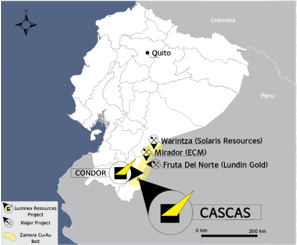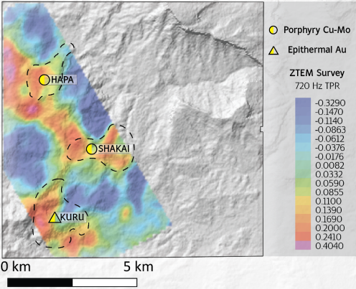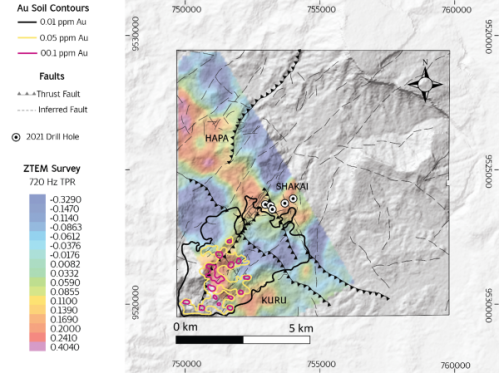CASCAS SUMMARY
New Targets - Potential New Discoveries
Three underexplored, prospective new targets:
- SHAKAI
- First drill test of copper-molybdenum porphyry target: 5 drillholes (2,017 m) completed in 2021
- Drill highlights include:
- 0.15% CuEq over 373m (SK21-01)
- 0.22% CuEq over 68.2m (SK21-03)
- Alteration and mineralization interesected during drilling suggest main porphyry body has yet to be intersected
- HAPA
- New, undrilled porphyry copper-molybdenum target
- Porphyry target with coincident broad (1 km in diameter) copper and molybdenum-in-soil anomaly (see NR21-11 Sep 21)
- KURU
- New, undrilled target
- Epithermal-style gold-silver mineralization discovered at surface with multiple coincident gold-in-soil anomalies
- Highest grade rock sample at the Cascas property: 54 g/t Au (at surface)
Cascas Location
The Cascas project is located in the Zamora-Chinchipe province of SE Ecuador, in the highly prospective Zamora Copper-Gold Belt. The Zamora Copper-Gold Belt is host to several major porphyry and epithermal deposits including: Fruta Del Norte (Lundin Gold), Mirador (EcuaCorriente) and Warintza (Solaris Resources).
The Cascas claim block consists of two, 100% owned, claims that cover a surface area of over ~10,000 hectares or 100 km2. The Cascas project consists of three main prospective targets: Shakai, Hapa and Kuru.
SHAKAI
Summary
The Shakai copper-molybdenum porphyry target is located in the centre of the Cascas claim block and consists of a 6 kilometre long, 1–2-kilometre wide, northwest trending copper-in-soil anomaly. This anomaly is coincident with a local conductive high, outlined by Luminex’s 2019 ZTEM survey. In 2021, five drill holes totalling 2,017 m were completed on the property.
The preliminary geological mapping completed by Luminex geologists, and subsequent scout drill program indicate multiple mineralized porphyritic intrusions. Long intercepts of bulk tonnage, low-grade porphyry-type copper-molybdenum mineralization was encountered in several drillholes. Drill highlights include:
| Drill Hole | From | To | Interval | Cu | Mo | CuEq |
|---|---|---|---|---|---|---|
| (final depth) | (m) | (m) | (m) | (%) | (ppm) | (%)* |
| SK21-012 | 33.0 | 406.0 | 373.0 | 0.13 | 88 | 0.15 |
| (569.8 m) | ||||||
| incl. | 33.0 | 52.0 | 19.0 | 0.15 | 69 | 0.18 |
| incl. | 312.0 | 366.0 | 54.0 | 0.18 | 138 | 0.23 |
| SK21-02 | 13.0 | 19.0 | 6.0 | 0.19 | 478 | 0.35 |
| (567.2 m) | ||||||
| and | 197.0 | 343.9 | 146.9 | 0.13 | 52 | 0.15 |
| and | 440.0 | 454.0 | 14.0 | 0.26 | 5 | 0.26 |
| SK21-03 | 75.0 | 135.6 | 60.6 | 0.15 | 60 | 0.17 |
| (263.2 m) | ||||||
| and | 195.0 | 263.2 | 68.2 | 0.19 | 89 | 0.22 |
*Copper equivalent calculation for reporting purposes only. The copper equivalent grade (CuEq) is calculated as follows: CuEq (%) = Cu (%) + 0.000333 × Mo (%) assuming prices of Cu US$3.00/lb and Mo US$10.00/lb. Minor gold and silver values not included.
Geology & Mineralization
The Shakai porphyry is hosted by a series of mineralized porphyritic granodiorite intrusions, with an approximate surface area of 2 km2. The porphyritic intrusions are crosscut by a series of north-west, and northeast trending faults. Shakai exhibits classic porphyry alteration and mineralization styles that are suggestive of a high-level preserved copper-molybdenum porphyry system. Mineralization is dominated by chalcopyrite +/- magnetite, chalcocite, covellite and molybdenite with secondary chrysocolla, malachite and rare native copper occurring at surface. Preliminary drill results, mineralization and alteration indicate that the main porphyry body may not have been intersected.

HAPA
Summary
The Hapa target is the northernmost target at the Cascas Project. Hapa consists of multiple porphyritic intrusions underlying a broad (1 km in diameter) copper and molybdenum anomaly. Hapa displays alteration and mineralization characteristic of a copper-molybdenum porphyry deposits including variable potassic and phyllic alteration haloes, copper-rich mineralization (chalcopyrite, chalcocite, covellite) and porphyry-style quartz veins. Hapa has never been drilled.
KURU
Summary
The Kuru target is located approximately 2 km to the southwest of the main Shakai target. Mineralization styles discovered at surface at Kuru are described, on a preliminary basis, as of low to intermediate sulfidation epithermal type. The Kuru target is delineated by several anomalous gold-in-soil anomalies. Coincident gold, silver and lead-in-soil anomalies correlate with localized intermediate intrusive dikes. A recent rock sample at Kuru returned a gold-grade of 54 g/t Au, the highest-grade sample recorded on the Cascas property to date. Kuru has never been drilled.
Qualified Person
Leo Hathaway, P.Geo, a "qualified person" within the definition of that term in NI 43-101, has reviewed and approved the scientific and technical information contained on this page.




